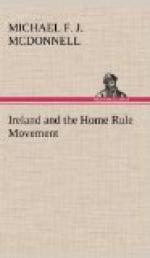On the day after the murder of Mr. Burke in the Phoenix Park a permanent Civil Servant was sent straight from the admiralty to take his place as Under Secretary. Sir Robert Hamilton who served in Dublin in those trying conditions became a convinced Home Ruler, as did his chief, Lord Spencer; and it is generally said to have been Sir Robert who converted Mr. Gladstone to Home Rule. On the return to power of the Conservatives, after the defeat of the Home Rule Bill of 1886, Sir Robert Hamilton was retired, and in his stead Sir Redvers Buller was sent to rule Ireland manu militari. This officer, on being examined by Lord Cowper’s Commission, expressed his opinion that the National League had been the tenants’ best, if not their only, friend. “You have got,” he said, “a very ignorant, poor people, and the law should look after them, instead of which it has only looked after the rich.” To hold opinions so unconventional in the service of a Unionist Viceroy was impossible, and in a year other fields for Sir Redvers’ activities were found. Sir West Ridgeway, who succeeded him, served as Mr. Balfour’s lieutenant during the latter’s efforts to “kill Home Rule with kindness,” and it is significant to find him at this day writing articles in the reviews on the disappearance of Unionism, and pinning his faith to Dunravenism as the next move.
It is assuredly a remarkable fact that the shrewdest of English statesmen have not been able to see the complication with which the Irish problem is entangled. Macaulay imagined that the religious difficulty was the crux of the Irish question, but Emancipation did not bring the expected peace and contentment in its train. John Bright imagined that the agrarian question was the only obstacle to reconciliation, but a recognition three-quarters of a century after the Union that the laws of tenure are made for man and not man for the laws of tenure, failed to put an end to Irish disaffection. Mr. Gladstone thought in 1870 that the Irish problem was solved. Complicated as the question has been in its various aspects—religious, racial, economic, and agrarian—our demands have too often and too long been met in the spirit of the Levite who passed by on the other side, until violence has forced tardy redress, acquiesced in with reluctance. If the action of Wellington and Peel was pusillanimous in granting Emancipation, for the express purpose of resisting which they were placed in power, backed as they were in their refusal by their allies in Ireland, the next great measures of reform forty years later were admitted by Mr. Gladstone himself to be equally the result of violence and breaches of the law. The Queen’s Speech of 1880 contained but a passing reference to Ireland and of the intention of the Government to rule without exceptional legislation; the Queen’s Speech of 1881 contained reference to little but Ireland and of the intention of the Government to introduce a Coercion Bill.




